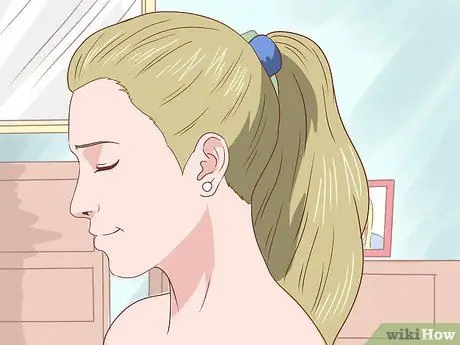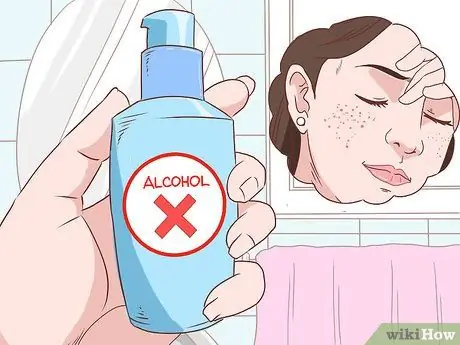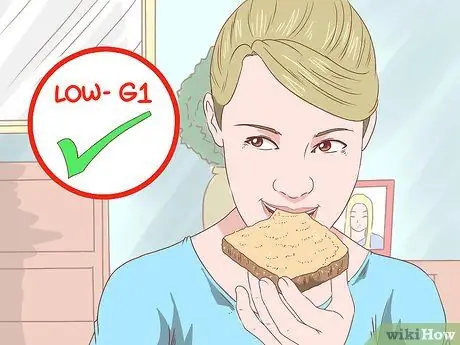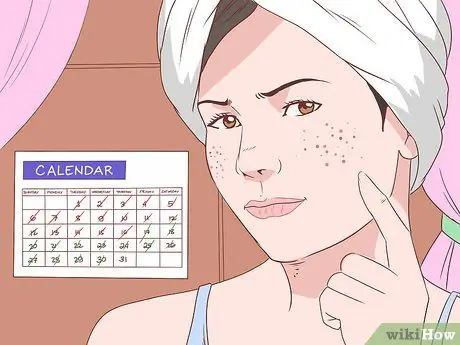Acne vulgaris (typically simply called acne) is a skin disease that occurs when dead skin cells and sebum (the oil that is naturally secreted by the body) clogs pores. When bacteria on the skin, called Propionibacterium acnes, enter the pores, it can cause inflammation and infection, resulting in pus formation. Acne causes blemishes such as open comedones (blackheads), closed comedones (whiteheads) and pimples, as well as more serious blemishes such as pustules, cysts and nodules. It is never pleasant to wake up in the morning and find a pimple on your face, but luckily you can treat most cases of moderate acne at home, thanks to good hygiene habits and natural remedies.
Steps
Part 1 of 6: Cleanse the Face with a Steam Bath

Step 1. Pull the hair away from your face
Use a headband or ponytail to keep your hair off your face.

Step 2. Give your face a "pre-wash treatment"
Rub a gentle cleanser, such as Dove or Cetaphil, into your skin, making light, circular movements with your fingertips for about a minute. At the end, rinse thoroughly.
- Use lukewarm water, too hot water can damage sensitive skin.
- Pat the skin dry with a clean cloth; do not rub or scrub!
- You can also choose a vegetable oil-based cleanser. Grapeseed or sunflower seeds are quite common in these types of soaps and help absorb and dissolve excess sebum from the skin.

Step 3. Do a small skin test with essential oils
Some people are allergic or sensitive to these products, so before using them to take a steam bath you should test them and make sure they are not harmful to you.
- Mix three drops of essential oil into 2.5ml of carrier oil, such as sunflower oil.
- Put a few drops of this solution on the gauze of a patch and apply it to the inside of the forearm. Leave it for 48 hours.
- If after this time your skin looks red, itchy, swollen, or you notice rashes, you shouldn't use that essential oil for your steam room.
- Thyme, oregano, clove and cinnamon oil can irritate the skin of some people. Many citrus-based oils can cause sunburn if you are exposed to the sun after application.

Step 4. Fill a saucepan with one liter of water
Bring it to a boil and let it boil for a minute or two.

Step 5. Add a drop or two of essential oil
Several essential oils have antibacterial or antiseptic properties and are capable of killing bacteria or other microorganisms on the skin that promote acne. Never ingest essential oils, as many are toxic and can cause unpleasant side effects when they enter the body. Here are some good options:
- Mint or Roman mint. Add a drop of oil for every quart of water, but you can also increase the dosage if necessary. Both products contain menthol, which has antiseptic properties.
- Thyme. This oil also has antibacterial properties and promotes blood circulation by dilating blood vessels.
- Calendula. It has antimicrobial properties and can accelerate skin healing.
- Lavender. In addition to being very soothing, this oil also has antibacterial properties.
- Rosemary. It is a natural antibacterial and is particularly effective against acne-causing microorganisms.
- Origan. It is an antibacterial and anti-inflammatory oil.
- Do not use tea tree oil for steam baths, as it is very toxic if swallowed.
- If you can't find essential oils, you can replace them with 2.5g of dried herbs.

Step 6. Transfer the pot to a solid surface
After adding the herbs and boiling them for a minute, remove the pot from the heat and place it on a comfortable, stable base, such as a kitchen counter or table.
It is advisable to place the hot pot on a trivet or cloth

Step 7. Cover your head with a large clean cotton towel
Put your face over the steaming pot and close your eyes.
Keep your face at least 30 cm from the water. Steam dilates blood vessels and opens pores, but getting too close to hot water can damage or even burn your skin

Step 8. Breathe normally
Try to relax and take deep soothing breaths. Stay in this position for 10 minutes.
If you start to feel discomfort before this time has elapsed, move away from the steam

Step 9. Rinse your face well
Use lukewarm water and pat dry with a clean towel, without rubbing the skin.

Step 10. Apply a non-comedogenic moisturizer
Get a product that doesn't clog your pores, such as those from the Olaz, Neutrogena, or Clinique brands. You can also make one yourself using natural oils.
Read the label of the products you buy. Choose one that does not clog pores (non-comedogenic) and does not contain oils

Step 11. Do this procedure up to twice a day
You can safely repeat these steam baths twice every day: in the morning and in the evening. After two weeks you should start noticing improvements.
When acne starts to subside, you can limit yourself to just one steam bath daily
Part 2 of 6: Using Sea Salt Treatments

Step 1. Never overdo saline treatments
Sea salt makes the skin's environment inhospitable for acne-causing bacteria, but it can also excessively dissolve the skin's natural oils. It can also dry out your skin if you overuse it. Please follow the guidelines below.
Before starting any saline treatments, use a mild cleanser to cleanse your face

Step 2. Make a salt mask
Mix one teaspoon of salt with three of boiling water in a small bowl or jar. Add a tablespoon of one of the following ingredients and mix well:
- Aloe vera gel (helps the skin to heal);
- Green tea (for its antioxidant and anti-aging properties);
- Raw honey (has antibacterial properties and promotes healing).

Step 3. Apply the mask thus composed on the face
After mixing the ingredients thoroughly, use your fingertips to gently spread it all over your face.
Alternatively, you can dip a cotton swab into the mixture and apply it only to the areas affected by acne

Step 4. Leave it in place for 10 minutes
Do not keep it on the skin for a longer period. Salt absorbs water from the skin and can dry out or irritate the skin a lot if you leave it on for too long.
- Rinse your face completely with warm or cold water.
- Pat your skin dry with a clean cloth.
- Apply a non-comedogenic moisturizer.
- Do not smear the saline mask more than once a day and always put on a moisturizing product at the end. It is recommended to do this treatment two or three times a week.

Step 5. Create a saline facial spray
Mix 50 g of salt with 150 ml of boiling water. Add 150ml of aloe vera gel, green tea or honey. Pour the mixture into a clean spray bottle.
Keep the bottle in the refrigerator to store the solution. Label it clearly so that no one is tempted to ingest the content

Step 6. Cleanse your face
Use a mild soap and wash your face. Then apply the spray making sure to close your eyes and spray the mixture all over your face and neck.
- Leave on for 10 minutes, but no longer to avoid possible irritation.
- At the end, rinse your face thoroughly with cold or lukewarm water.
- Pat dry gently with a clean towel.
- Apply a non-comedogenic moisturizer.

Step 7. Take a salt water bath
Pour 400 g of sea salt into the tub while filling it with very hot or boiling water. Add it as the water flows from the tap, so that it dissolves easily. You can also use common table salt, although it does not contain all the minerals found in whole sea salt and therefore is not as effective.
- Soak in the tub for 15 minutes.
- To treat acne on your face, wet a washcloth with salt water and place it on your skin for 10-15 minutes, closing your eyes, as the salt may irritate them.
- At the end, rinse your body thoroughly with fresh water to remove all the salt.
- Blot the leather with a clean cloth.
- Apply a non-comedogenic moisturizer.
Part 3 of 6: Using Natural Facial Treatments

Step 1. Make a mask for oily skin
Combine one tablespoon of raw honey with one egg white, one teaspoon of lemon or witch hazel juice, and half a teaspoon of peppermint, spearmint, calendula, or thyme essential oil. Mix the ingredients thoroughly to blend them.
- Raw honey has antibacterial and astringent properties.
- The egg white thickens the mixture and performs an astringent function.
- Lemon juice is also an astringent and also has whitening properties. Witch hazel is just as astringent, but it doesn't act as a whitener.
- The essential oils listed above have antiseptic or antibacterial properties and can kill germs on the skin.

Step 2. Apply the mask to the skin
Use your fingertips to gently smear the mixture on your face, neck, or other problem areas. You can also use a cotton swab and apply the mask only on blemishes and areas affected by acne.
Wait for the mask to dry for about 15 minutes

Step 3. At the end rinse with lukewarm water
Make sure you wash your skin thoroughly, avoiding leaving any residue that would otherwise clog the pores.
- Pat your skin dry with a clean cloth.
- Apply a non-comedogenic moisturizer.

Step 4. Make an oatmeal mask
The starch contained in this flour is known to be able to eliminate sebum and at the same time moisturize the skin. Oatmeal is also a natural anti-inflammatory that soothes irritated skin and inflamed pores.
- Add 85g of rolled oats to 160ml of boiling water. Mix well and wait for the solution to cool.
- Add 85 g of raw honey to the cooled oatmeal mixture and mix well. Honey acts as an antibacterial and moisturizing agent.

Step 5. Apply the mask to clean skin
Use your fingertips to gently spread it all over your face, neck or other areas to be treated.
- Wait up to 20 minutes for it to dry.
- At the end, rinse well with mild soap and warm water.
- Pat your skin dry with a clean cloth.
- Apply a non-comedogenic moisturizer.

Step 6. Apply tea tree oil
Buy a product that contains 5% of this oil. Wet a cotton ball and dab it on acne-prone areas once a day for three months. Tea tree oil works longer than benzoyl peroxide, which is commonly used in topical acne products, but it also has fewer side effects, such as dryness, itching or irritation.
- Do not ingest tea tree oil, as it is toxic if it enters the body. If you have eczema, rosacea, or other skin conditions, this oil can further irritate your skin. Consult a dermatologist before using it.
- If you want to get a little faster results, you can apply the oil twice a day for 20 minutes each time. Finally rinse with a mild cleanser like Cetaphil. Follow the treatment constantly for 45 days.
Part 4 of 6: Clean the Skin

Step 1. Wash your face, but don't overdo it
If you wash your skin too often, you can irritate it and make it red. Limit yourself to twice a day and after sweating.
- Use a mild soap such as Dove, Aveeno or Cetaphil and not a generic hand soap. Make sure the label says "non-comedogenic" or another similar description to make sure the soap doesn't cause acne breakouts.
- Wash your face with soap and water using clean finger tips. Gently massage without rubbing. If you apply too much pressure or use an abrasive item such as a washcloth or mesh sponge, it can cause irritation or even scarring.
- Wash your face after sweating, especially if you're wearing a hat or helmet. If sweat prevents the skin from perspiring properly and gets trapped on the skin, then the acne inflammation gets worse.

Step 2. Avoid exfoliating the skin
Exfoliating products or accessories are quite common, but in the case of acne they can irritate and cause scars, aggravating the situation. Limit yourself to neutral detergents and fingers.
Chemical exfoliants such as salicylic acid and alpha hydroxy acids chemically detach dead and dying skin cells. However, they can dry out the skin, so you shouldn't overuse them

Step 3. Do not use soaps or cleaners that contain alcohol
Skin products such as tonics, astringents, and exfoliants are often alcohol-based. However, this ingredient dries the skin, irritating it and promoting acne breakouts.

Step 4. Shower once a day
Washing regularly allows you to remove excess sebum from the hair which, coming down from the face, can cause skin rashes. Since acne can develop anywhere on the body, a mild, non-comedogenic soap should be used.

Step 5. Change your make-up and skin products in general
Heavy, greasy cosmetics can clog pores and cause breakouts. If you suffer from acne often, it could be due to poor skin care.
Choose cosmetics and skin care products that clearly label "non-comedogenic". This means that they do not clog pores and do not cause skin breakouts. Also check that they are "oil free". When you can, choose water-based or mineral-based make-up products
Part 5 of 6: Making Lifestyle Changes

Step 1. Don't squeeze the pimples
By squeezing them, you can push the bacteria even deeper into the skin. If you squeeze, tease, squeeze, or touch acne blemishes, you can leave scars, sometimes even permanent ones.
In severe cases, you may also develop a staph infection by squeezing a pimple, so avoid doing this

Step 2. Wash your pillow case often
The sebum and debris left by the skin can remain on the pillow, creating an environment conducive to the formation of pimples. You should wash or change the pillowcase every few days to reduce the risk of developing acne.

Step 3. Avoid sun exposure and don't use tanning beds
Ultraviolet rays (such as sunlight and tanning lamps) can cause severe skin damage and even aggravate acne.
- If you are taking certain medications, such as antibiotics, antihistamines, and acne-specific ones (such as isotretinoin or topical retinoids), then sun exposure can redden, dry, and irritate the skin.
- Some sun creams can cause acute phases of acne. Choose an oil-free product or a full-screen cream that contains zinc oxide or titanium dioxide.

Step 4. Take the stress away
Stress is not directly responsible for acne, but it aggravates the situation when it is already present. Although it is inevitable to experience tensions and worries every day, you can try to lighten the burden by approaching things in a natural way.
- Try meditation or yoga. The visualization technique or surrounding yourself with relaxing things often reduces the effects of stress and assumes a relaxed attitude.
- Go to the gym. Run, lift weights, and work to "cut" the stress out of your life. The release of endorphins during physical activity helps improve mood.
- Examine the environment around you. The workplace or home environment can be emotionally toxic, but air pollutants and food additives can also cause anxiety.

Step 5. Pay attention to the power supply
Diet is not a direct cause of acne, but it can increase inflammation and promote bacterial growth. Avoid sugary, heavily processed foods and instead opt for those low-glycemic foods, which help reduce acne severity. Some low-glycemic foods are:
- Bran, muesli and oat flakes;
- Whole grains, pumpernickels, and other types of wholemeal bread
- Most fruit and vegetables;
- Dried fruits and legumes;
- Yogurt.
Part 6 of 6: Knowing When to See Your Doctor

Step 1. Count the number of imperfections
Dermatologists distinguish between mild, moderate or severe acne. When acne is mild it can be treated at home with topical remedies and lifestyle changes. If it is moderate or severe, however, you need to see your doctor.
- Mild facial acne typically has fewer than 20 non-inflamed black or whiteheads or 15-20 mildly inflamed and irritated pimples.
- With moderate facial acne there are between 20 and 100 white or blackheads or 15-50 pimples.
- Severe facial acne has more than 100 white or blackheads, more than 50 pimples, or more than 5 cysts (deeper inflamed lesions).

Step 2. Wait two to four weeks
If your acne persists beyond this period without showing any signs of improvement despite having practiced the methods described so far, make a doctor's appointment. He will be able to suggest treatments or advise you to see a dermatologist if necessary.
If you have private insurance, you can check if your policy provides coverage for this type of visit. Contact the insurance company and find out

Step 3. See your doctor if you experience any side effects
In some people with sensitive skin, home acne treatments can cause irritation. If the skin becomes red, inflamed or irritated, stop treatment and see your doctor.
Advice
- When washing your face, don't rub it with a towel. It is best to use your hands, as the cloth could further spread the infection throughout the face and irritate the skin.
- When applying hair gels or sprays, you should avoid them coming into contact with the skin on your face, as they may clog the pores.
- Get adequate amounts of vitamins A and D in your diet, as they are important for skin health.
- When you put on make-up always make sure that it is "non-comedogenic" or "non-acnegenic" products.
- Eat lots of foods rich in omega-3 fatty acids, including fish like salmon, tuna, and mackerel. Flax seeds are also a great source of these nutrients, as are walnuts and chia seeds. Omega-3s are really beneficial for people with acne.
Warnings
- Never squeeze, squeeze or pinch pimples, you could cause irritation, scarring and serious infections.
- Don't make a salicylic acid mask yourself using aspirin. This substance causes skin damage if not applied properly. Use only doctor-approved topical creams.






